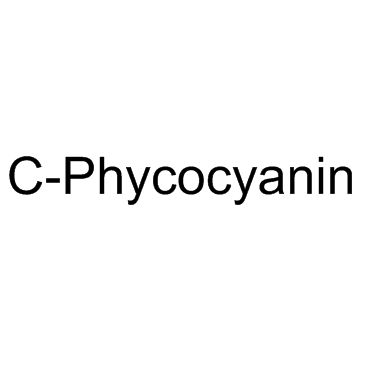C-Phycocyanin

C-Phycocyanin structure
|
Common Name | C-Phycocyanin | ||
|---|---|---|---|---|
| CAS Number | 11016-15-2 | Molecular Weight | N/A | |
| Density | N/A | Boiling Point | N/A | |
| Molecular Formula | N/A | Melting Point | N/A | |
| MSDS | USA | Flash Point | N/A | |
| Symbol |


GHS06, GHS09 |
Signal Word | Danger | |
|
Investigation on the role of Spirulina platensis in ameliorating behavioural changes, thyroid dysfunction and oxidative stress in offspring of pregnant rats exposed to fluoride.
Food Chem. 140(1-2) , 321-31, (2013) The study investigated the role of Spirulina platensis in reversing sodium fluoride-induced thyroid, neurodevelopment and oxidative alterations in offspring of pregnant rats. The total antioxidant activity, phycocyanins, and β carotene content were quantified... |
|
|
Structure of the cyanobacterial phytochrome 2 photosensor implies a tryptophan switch for phytochrome signaling.
J. Biol. Chem. 288(50) , 35714-25, (2013) Phytochromes are highly versatile photoreceptors, which occur ubiquitously in plants as well as in many light-responsive microorganisms. Here, photosynthetic cyanobacteria utilize up to three different phytochrome architectures, where only the plant-like and ... |
|
|
DA virus mutant H101 has altered CNS pathogenesis and causes immunosuppression.
J. Neuroimmunol. 277(1-2) , 118-26, (2014) Viruses use various mechanisms to evade clearance by the host. Investigating how a few changes in the genome of a non-lethal virus can lead to altered disease, from survivable to immunosuppression/death, would provide valuable information into viral pathogene... |
|
|
Phycobiliproteins or C-phycocyanin of Arthrospira (Spirulina) maxima protect against HgCl(2)-caused oxidative stress and renal damage.
Food Chem. 135(4) , 2359-65, (2012) Our objective was to determine if the phycobiliproteins of Arthrospira (Spirulina) maxima protect renal cells against mercury-caused oxidative stress and cellular damage in the kidney. We used 40 male mice that were assigned into eight groups: (1) a control g... |
|
|
Molecular cloning and expression analysis of a new bilin lyase: thecpcTgene encoding a bilin lyase responsible for attachment of phycocyanobilin to Cys-153 on the β-subunit of phycocyanin inArthrospira platensisFACHB314
Gene 544(2) , 191-7, (2014) To study the assembly of phycocyanin β subunit, the gene cpcT was first cloned from Arthrospira platensis FACHB314. To explore the function of cpcT, the DNA of phycocyanin β subunit and cpcT were transformed into Escherichia coli BL21 with the plasmid pET-hox... |
|
|
Flow cytometric evaluation of lymphocyte transformation test based on 5-ethynyl-2'deoxyuridine incorporation as a clinical alternative to tritiated thymidine uptake measurement.
J. Immunol. Methods 415 , 71-9, (2014) In clinical laboratories, the evaluation of lymphocyte proliferative response (lymphocyte transformation test-LTT) is routinely performed by the measurement of [(3)H]-thymidine uptake after stimulation. In this study we evaluated the performances of a recentl... |
|
|
Salinity impacts photosynthetic pigmentation and cellular morphology changes by distinct mechanisms in Fremyella diplosiphon.
Biochem. Biophys. Res. Commun. 433(1) , 84-9, (2013) Fremyella diplosiphon is a freshwater cyanobacterium that exhibits complementary chromatic adaptation (CCA), which allows the organism to alter its pigmentation and cellular morphology to maximally harvest available green light (GL) and red light (RL) at diff... |
|
|
Immunomodulatory properties of the protein fraction from Phorphyra columbina.
J. Agric. Food Chem. 60(33) , 8146-54, (2012) The phycobiliproteins from Rhodophyta , R-phycoerythrin (R-PE) and C-phycocyanin (C-PC), have been shown to exert immunomodulatory effects. This study evaluated the effects of a Phorphyra columbina protein fraction (PF) and R-PE and C-PC on rat primary spleno... |
|
|
Anilofos tolerance and its mineralization by the cyanobacterium Synechocystis sp. strain PUPCCC 64.
PLoS ONE 8(1) , e53445, (2013) This study deals with anilofos tolerance and its mineralization by the common rice field cyanobacterium Synechocystis sp. strain PUPCCC 64. The organism tolerated anilofos up to 25 mg L(-1). The herbicide caused inhibitory effects on photosynthetic pigments o... |
|
|
In silico model of an antenna of a phycobilisome and energy transfer rates determination by theoretical Förster approach.
Protein Sci. 21(12) , 1921-8, (2012) Energy transfer (ET) in phycobilisomes, a macrocomplex of phycobiliproteins and linker proteins, is a process that is difficult to understand completely. A model for a rod composed of two hexamers of Phycocyanin and two hexamers of Phycoerythrin was built usi... |